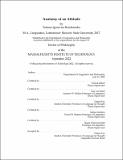Anatomy of an Attitude
Author(s)
Bondarenko, Tatiana Igorevna
DownloadThesis PDF (5.129Mb)
Advisor
Elliott, Patrick
von Fintel, Kai
Fox, Danny
Iatridou, Sabine
Schwarzschild, Roger
Terms of use
Metadata
Show full item recordAbstract
This thesis investigates syntax and semantics of attitude and speech reports. It is concerned with three questions: (i) what kinds of meanings can tensed embedded clauses have? (ii) how are they integrated into the argument structure of verbs? (ii) why does their distribution sometimes depend not only on the argument structure, but on the embedding environment as well?
Chapter 1 provides a brief summary of my proposal and outlines the assumed framework. Chapter 2 examines clauses that combine with nouns like 'claim' and 'situation' in Buryat, Korean and Russian. It argues that displacement in attitude and speech reports comes from a projection ContP in the left periphery of embedded clauses (cf. Kratzer 2006, Bogal-Allbritten 2016, a.o.), and clauses differ in whether they have ContP and thus displacement. I also argue for equality semantics of displacement (Moulton 2009, Elliott 2017): clausal embedding does not involve semantics of a universal modal. Chapter 3 examines conjunction and disjunction of embedded CPs, and shows that interpretations of these structures, as well as the impossibility of true CP conjunction follow from my proposal. Chapter 4 investigates how nominalized and bare CPs are integrated with verbs in Buryat, Korean and Russian, and shows that they systematically receive different interpretations. I argue that this difference emerges because while nominalized CPs are arguments of verbs, bare CPs are always modifiers. I show that the integration path of an embedded CP, as well as its internal structure, matter for whether it is transparent for extraction or behaves like an island. Chapter 5 examines two types of polarity subjunctives in Russian: embedded subjunctive clauses whose ability to occur with certain verbs depends on the entailment properties of the environment. I argue that the subjunctive particle activates alternatives which have to be acted upon by a higher focus operator, and intervening projections, including ContP, can change the set of alternatives that the operator receives, making the sentence L-analytic and thus ungrammatical (Gajewski 2002, a.o.) in some cases but not in others. Chapter 6 summarizes the findings of the thesis, and the typology of tensed embedded clauses that it gives rise to.
Date issued
2022-09Department
Massachusetts Institute of Technology. Department of Linguistics and PhilosophyPublisher
Massachusetts Institute of Technology